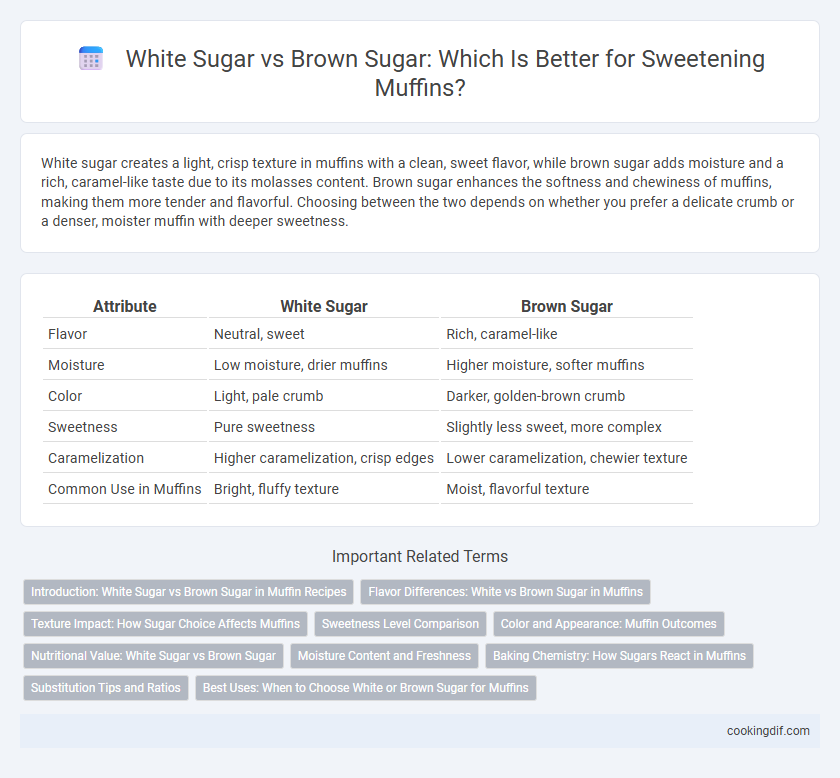White sugar creates a light, crisp texture in muffins with a clean, sweet flavor, while brown sugar adds moisture and a rich, caramel-like taste due to its molasses content. Brown sugar enhances the softness and chewiness of muffins, making them more tender and flavorful. Choosing between the two depends on whether you prefer a delicate crumb or a denser, moister muffin with deeper sweetness.
Table of Comparison
| Attribute | White Sugar | Brown Sugar |
|---|---|---|
| Flavor | Neutral, sweet | Rich, caramel-like |
| Moisture | Low moisture, drier muffins | Higher moisture, softer muffins |
| Color | Light, pale crumb | Darker, golden-brown crumb |
| Sweetness | Pure sweetness | Slightly less sweet, more complex |
| Caramelization | Higher caramelization, crisp edges | Lower caramelization, chewier texture |
| Common Use in Muffins | Bright, fluffy texture | Moist, flavorful texture |
Introduction: White Sugar vs Brown Sugar in Muffin Recipes
White sugar creates a lighter, crispier texture in muffins with a clean, sweet flavor, while brown sugar adds moisture and a rich, caramel-like taste due to its molasses content. Muffin recipes using brown sugar tend to be denser and more flavorful, enhancing the overall moistness and depth. Choosing between white and brown sugar directly influences the color, texture, and sweetness complexity of the final baked muffin.
Flavor Differences: White vs Brown Sugar in Muffins
White sugar imparts a clean, sweet flavor to muffins, enhancing their natural taste without altering texture significantly. Brown sugar, containing molasses, adds a richer, caramel-like flavor and retains more moisture, resulting in softer, denser muffins. Choosing between white and brown sugar impacts both the flavor profile and the crumb texture, making brown sugar ideal for deeper, more complex tastes.
Texture Impact: How Sugar Choice Affects Muffins
White sugar creates a light and tender crumb in muffins by dissolving easily and promoting aeration during mixing. Brown sugar, containing molasses, adds moisture and results in a denser, chewier texture with a rich, caramel-like flavor. Choosing between white and brown sugar significantly influences the moisture retention and overall mouthfeel of baked muffins.
Sweetness Level Comparison
White sugar typically offers a higher sweetness level compared to brown sugar when used in muffin recipes, due to its pure sucrose content. Brown sugar contains molasses, which imparts a slightly less sweet but richer and more complex flavor, influencing the overall taste profile rather than just sweetness. Choosing white sugar results in a cleaner, sweeter muffin, while brown sugar yields a moist texture with a subtle caramel note.
Color and Appearance: Muffin Outcomes
White sugar produces muffins with a lighter, pale golden color and a uniform, fine crumb texture. Brown sugar imparts a deeper, richer brown hue and contributes to a moister, denser crumb due to its molasses content. Choosing between white and brown sugar significantly affects the visual appeal and texture of the final muffin outcome.
Nutritional Value: White Sugar vs Brown Sugar
White sugar and brown sugar differ slightly in nutritional value, with brown sugar containing trace amounts of minerals such as calcium, potassium, and iron due to its molasses content. Both sugars provide similar calorie content, approximately 15-16 calories per teaspoon, making their impact on muffin sweetness and energy contribution nearly equivalent. Brown sugar imparts a slightly higher moisture content, which can influence the texture of muffins more than the minimal nutritional differences.
Moisture Content and Freshness
Brown sugar contains higher moisture content compared to white sugar, which helps keep muffins softer and fresher for a longer period. The molasses in brown sugar attracts and retains water, contributing to a moist, tender crumb. Using white sugar results in a drier texture and shorter freshness due to its lack of moisture-retaining properties.
Baking Chemistry: How Sugars React in Muffins
White sugar caramelizes at a higher temperature, providing a crisp outer texture and lighter crumb in muffins, while brown sugar contains molasses, which adds moisture and acidity that enhances muffin softness and promotes chemical leavening. The molasses in brown sugar reacts with baking soda to produce carbon dioxide, contributing to a tender crumb and deeper flavor profile. White sugar's pure sucrose structure allows for more predictable browning through the Maillard reaction, making it ideal for achieving a golden crust.
Substitution Tips and Ratios
When substituting white sugar with brown sugar in muffin recipes, use a 1:1 ratio to maintain sweetness while adding moisture and a slight caramel flavor. Brown sugar's higher moisture content may result in denser, chewier muffins, so reduce liquid ingredients slightly if batter feels too wet. For lighter texture, blend half white sugar and half brown sugar, balancing sweetness with moistness.
Best Uses: When to Choose White or Brown Sugar for Muffins
White sugar produces lighter, fluffier muffins with a mild sweetness, ideal for recipes where a delicate crumb and pale color are desired. Brown sugar adds moisture, a rich caramel flavor, and a denser texture, making it perfect for hearty muffins like banana or spice varieties. Choosing between white and brown sugar depends on whether the recipe prioritizes tenderness and subtle sweetness or depth of flavor and moistness.
White sugar vs Brown sugar for sweetening muffins Infographic

 cookingdif.com
cookingdif.com